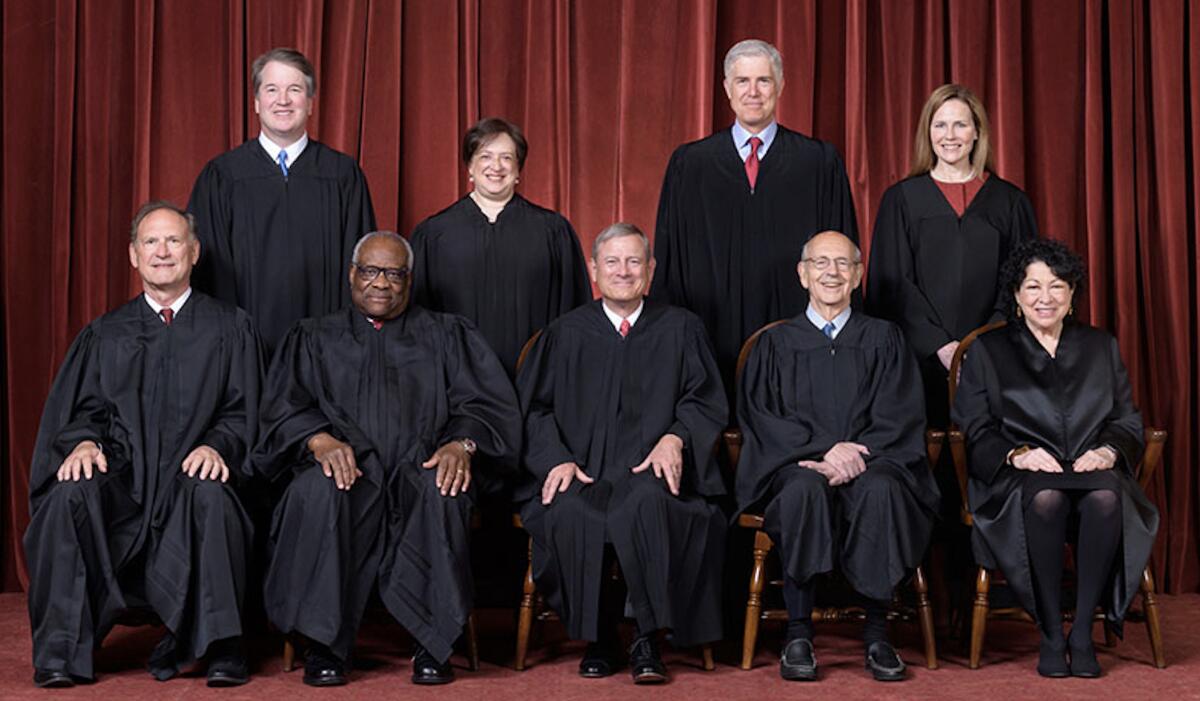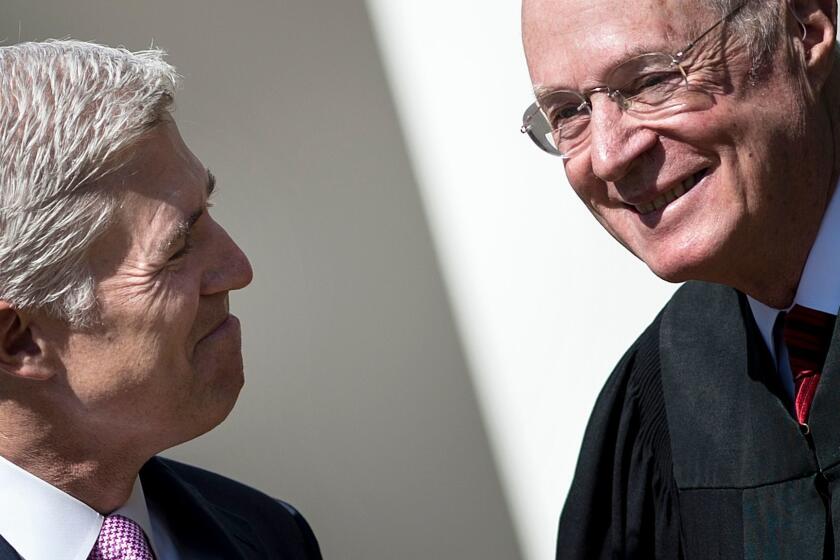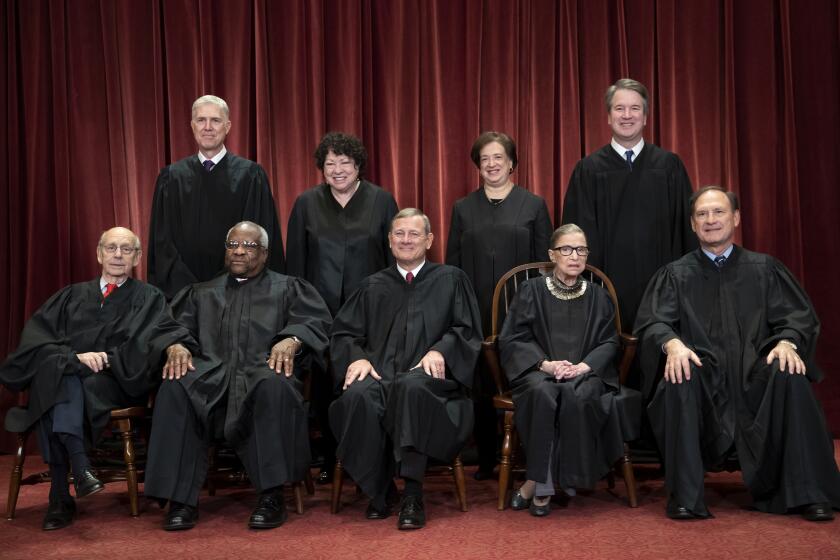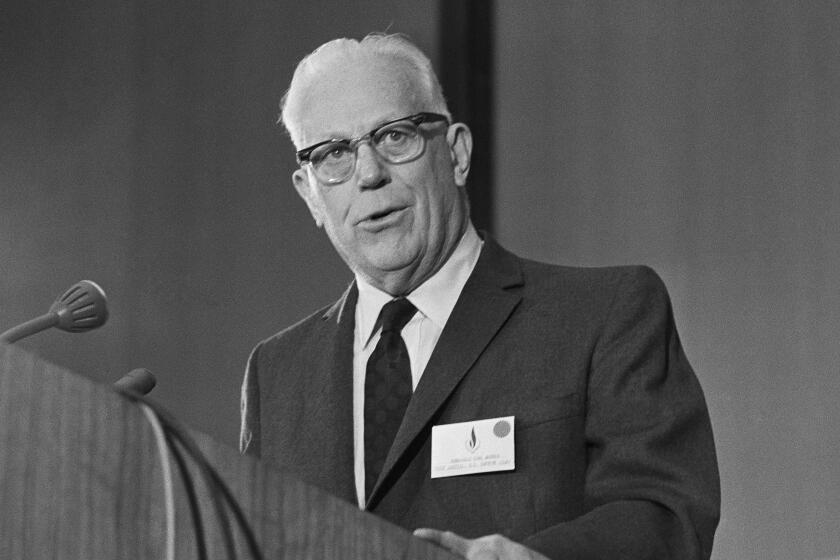The idea of expanding the Supreme Court to blunt its right-wing bias gains traction

- Share via
We may be approaching an inflection point that would lead to a dramatic reshaping of the Supreme Court. That would be a good thing.
The idea of expanding the court beyond its current complement of nine justices has been getting increased attention in public debate in recent months.
Long skirted by all but the most determined political progressives, the notion has been gaining traction lately, thanks in part to the court’s distinct rightward tilt, its increasingly partisan character, and its apparent hostility to abortion rights.
What we face for a long time to come is a court that is substantially more conservative than the American public.
— UC Berkeley law school dean Erwin Chemerinsky
The dubious Senate maneuvering that delivered two seats that should have been filled by Democratic presidents to conservatives instead has shaken perceptions of the court’s very legitimacy.
President Biden lent validity to the debate, if not to the idea itself, by empaneling a commission to examine court expansion and other possible reforms such as term limits for justices. (Biden has said he opposes court expansion, so he may not have been disappointed by the commission’s failure to recommend any substantive reforms.)
Get the latest from Michael Hiltzik
Commentary on economics and more from a Pulitzer Prize winner.
You may occasionally receive promotional content from the Los Angeles Times.
Uneasiness about the majority’s apparent willingness to overturn Roe vs. Wade, the landmark 1973 decision that overturned abortion restrictions, has focused more public attention on its sharp turn toward the right wing.
But more is at issue. Two members of Biden’s commission, retired federal judge Nancy Gertner and Lawrence H. Tribe, an emeritus constitutional law professor at Harvard, wrote on Dec. 9 that “the anti-democratic, anti-egalitarian direction of this court’s decisions about matters such as voting rights, gerrymandering and the corrupting effects of dark money” justified expanding the court “as soon as possible.”
Three days later, two other members, former federal judges Thomas B. Griffith and David F. Levi, countered that most of the reforms considered by the panel — especially “term limits and expanding the number of justices, or ‘court-packing’ ... would not address any deficiency in the court or its procedures. But they would threaten judicial independence.”
Expanding the court was most notably proposed in 1937 by Franklin D. Roosevelt, irked by the court’s overturning of several New Deal initiatives. But it’s not a new idea even in the modern context. Erwin Chemerinsky, dean of the UC Berkeley School of Law, proposed it to defang the risk of a serious tilt to the right in 2020, after the death of liberal Justice Ruth Bader Ginsberg.
With the prospect looming of a Supreme Court dominated by Trump-appointed right-wing judges into the foreseeable future, an idea for a possible counterstroke has begun percolating among progressive political analysts and legal theorists: Expand the court from the current nine justices to provide for a more balanced, if not distinctly liberal, bench.
“Last term, with Ginsburg on the bench, the court handed down surprising 5-4 decisions to protect individual rights,” Chemerinsky wrote in a Times op-ed. “If Ginsburg is replaced by a hard-line conservative who puts politics and feelings ahead of the law, the chance of such rulings will evaporate.”
At that time, Chief Justice John G. Roberts Jr. was viewed as a somewhat conservative swing vote.
However, Chemerinsky observed, if Ginsberg were replaced by Donald Trump “with someone from the far right, like Judge Amy Coney Barrett, who is frequently mentioned as a likely nominee, there will be five justices substantially more conservative than Roberts. There would be virtually no hope that abortion rights could survive such a court, and little chance of checking Trump.”
The possible remedy, Chemerinsky argued, was for “Democrats to make clear they will not tolerate Republicans trying to fill this seat in advance of the election” by pledging that if they take the White House and Senate in the November 2020 election, “they will increase the size of the Supreme Court to 13 justices.”
Chemerinsky was prescient. Trump did appoint Barrett, the conservative bloc is now dominant, and abortion rights are in deep jeopardy. But Democrats didn’t make the threat he advocated, and despite holding the White House and a narrow Senate majority, haven’t acted.
The necessity of doing so has only gained urgency, Chemerinsky told me.
With Barrett on the court, acting in concert with conservative justices Clarence Thomas, Samuel A. Alito Jr., Neil M. Gorsuch and Brett M. Kavanaugh, “What we face for a long time to come is a court that is substantially more conservative than the American public,” he says.
Shifting the court to a more centrist point on the ideological spectrum may be crucial to preserving its legitimacy in the public’s eye. The institution’s credibility currently sits on a knife edge. The Gallup organization reported in September that public approval of the court had plummeted to 40%, down from 49% in July — a “new low” in Gallup polling dating back to 2000.
If Democrats take the Senate and the White House, repacking the Supreme Court is imperative.
“I accept that increasing the size of the court might affect its legitimacy,” Chemerinsky says, “but we’re already there.”
Doubts are even coming from inside the house. During oral arguments on Dec. 3 on a Mississippi abortion law in which the court majority appeared open to overturning Roe vs. Wade, Justice Sonia Sotomayor asked: “Will this institution survive the stench that this creates in the public perception that the Constitution and its reading are just political acts? I don’t see how it is possible.”
The 36-member Biden commission disappointed many followers of the debate when it issued its final report draft this month by failing to take a firm stand in favor of any proposals, expansion or otherwise.
“What’s missing from the report ... is a frank diagnosis of the legitimacy problem facing the Supreme Court today,” wrote Gabe Roth, executive director of the reform advocacy group Fix the Court.
Critics of court expansion assert that it would “politicize” the appointment process and the institution itself, as Griffith and Levi argued in their op-ed. Given actual developments, that sounds like some sort of a gag.
The appointment process was hopelessly politicized through two hypocritical actions by the Republican Senate: First, its refusal to grant President Obama’s nominee, Merrick Garland, even the courtesy of a hearing in 2016, on the argument that no justice should be appointed during a presidential election year, to give the next president the choice. Garland’s seat was eventually filled by Trump with Gorsuch in 2017.
That was followed by the GOP majority’s rushed confirmation of Amy Coney Barrett, a far-right choice of President Trump, on Oct. 26, 2020, just nine days before a pending presidential election (one that also sent the GOP into the Senate minority).
“That’s when you really began to see people talking” about expanding the court, Chemerinsky says.
The consequences of having a court this conservative was further brought home by the majority’s approach to the pivotal issue of abortion rights. The majority’s refusal to enjoin the draconian and cynical Texas abortion law, SB 8, which many legal scholars say is flagrantly unconstitutional, “makes real what it means to have a Court this conservative,” Chemerinsky told me.
Debate over expanding the court tends to be overshadowed by the eight-decade-old precedent of FDR’s 1937 “court packing” scheme, a proposal to add a new justice whenever an existing justice turned 70, up to a maximum of 15.
Although the Constitution explicitly gives Congress responsibility for the size of the Supreme Court, Roosevelt’s effort turned into what may have been his most serious failure as a political leader. Due in part to a series of uncharacteristic missteps, political and public opposition eventually forced FDR to withdraw the proposal. It may be instructive, however, to examine the difference between then and now.
FDR was hoping to ride a surge of public discontent with the court, following a string of rulings overturning New Deal initiatives and guided by a unified bloc of four conservative justices. This discontent increased in the wake of a 1936 ruling known as Tipaldo, after its contemptible protagonist, a slave-driving New York factory owner, overturning a New York minimum wage law.
The ruling, which cited the supposed sanctity of the contract between employers and their employees, even turned two old adversaries into united critics of the court.
They were Herbert Hoover, who proposed a constitutional amendment to overturn Tipaldo, and Interior Secretary Harold Ickes, a liberal Republican who had led the “dump Hoover” movement at the 1932 GOP convention and who castigated the court for upholding “the sacred right ... of an immature child or a helpless woman to drive a bargain with a great corporation.”
Ickes added, “If this decision does not outrage the moral sense of the country, then nothing will.”
The conservative bloc of that era was not impregnable, however. Then-Chief Justice Charles Evans Hughes masterminded a course correction for the court, initially by persuading Owen Roberts, a swing justice, to vote to uphold a Washington state minimum wage law almost identical to the New York statute he had voted to overturn.
The court subsequently took a more indulgent approach to New Deal initiatives, upholding Social Security and collective bargaining rights under the National Labor Relations Act. That blunted popular discontent. (The vote change by Roberts on minimum wage law was dubbed “the switch in time that saved nine.”)
Yet there was no question then of the legitimacy of the court appointments, as there is now. Hughes, moreover, had more latitude to maneuver the court back to the center than the current chief justice, Roberts, does today.
Chief Justice Roberts appears to be on the outs with the rest of the court’s current conservative majority. Among other indications, he was outvoted twice on the Texas abortion law, 5-4 — first on a Sept. 1 ruling that allowed the law to go into effect, even as a challenge to its constitutionality was pending, and again on Dec. 10, when the majority refused to enjoin the law.
Hiltzik: The talk of raising a statue to Earl Warren would force a reckoning with his racist record
The dark side of Earl Warren’s past is his advocacy of Japanese incarceration during World War II.
“The chief justice had over three months to change a single mind on the conservative flank of the court,” observed Slate’s Dahlia Lithwick. “He failed to do so.” Instead, he was reduced to grousing in a dissent that “the clear purpose and actual effect of S. B. 8 has been to nullify this Court’s rulings....[I]t is the role of the Supreme Court in our constitutional system that is at stake.”
As Lithwick concludes, “Chief Justice John Roberts has now lost control of his court.”
A straight-on expansion of the court isn’t the only option that has been placed on the table to counter the obvious partisan mismatch of its membership. The discrepancy may be mostly due to the luck of the natural draw, but it exists nonetheless. As Chemerinsky observes, from 1960 through 2020, Republicans have held the White House for 32 years and Democrats for 28, almost an even split. But Republicans have appointed 15 justices and Democrats only eight.
That counts Gorsuch and Barrett, the beneficiaries of GOP cheating, but even if those seats went to Democratic nominees, the score would still have been 13-10 in Republicans’ favor.
Advocates of reform who are concerned about a permanent tit-for-tat expanding of the court every time the White House and Senate change parties have proposed any number of alternatives to flat expansion. Jack Balkin, a constitutional law expert at Yale and a member of Biden’s commission, proposed in 2020 a series of steps to avoid “brute exercises of political power” in court appointments.
Balkin advocated allowing every president to appoint a new justice in every odd-numbered year, but dividing the court in two — one panel comprising all active justices to hear cases derived from the court’s original Constitutional jurisdiction, and a second category consisting of the court’s nine most junior justices to hear appeals from lower courts. That panel would change every two years, with a newly appointed justice replacing the oldest one on the panel.
In that system, “politicians no longer have incentives to nominate very young judges” to preserve long-lived influence, because the judges would only have authority over appellate cases for 18 years (at which point they would age out of that panel). “So if politicians want to influence the composition of the Court, the best way is to keep winning presidential elections.”
That might solve the problem of Justices holding on to their influence long after the electorate has turned away their original sponsors. At least it would get to the nub of the problem with today’s court: Its apparent hostility to principles that the American public plainly holds dear — the preservation of abortion rights, expansion of gun control, the infusion of special interest cash into elections, and the fairness of the electoral process itself.
As Chemerinsky, Gertner and Tribe have observed, a crisis of judicial legitimacy is upon us. Not only the court’s future, but that of American democracy, is at stake.
More to Read
Get the latest from Michael Hiltzik
Commentary on economics and more from a Pulitzer Prize winner.
You may occasionally receive promotional content from the Los Angeles Times.














